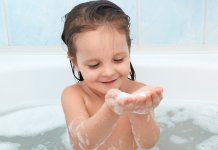Fingers, Ears, Nose And Toes
During their first year, children see themselves as one with their caregiver, most often their parents. However, this starts to change once they get past their first twelve months, becoming more independent each day and seeing themselves separately from their primary caregiver. To help your children grasp better the concept of ‘me,’ you can start introducing to them their individual body parts, identifying each of these in the possessive form, such as ‘Liam’s nose,’ or ‘Angelina’s eyes.’ For better illustration, you can follow up by pointing at your corresponding body part, such as ‘Mommy’s nose’ after pointing out ‘Liam’s nose,’ or ‘Daddy’s eyes following ‘Angelina’s eyes.’
Here are some ways by which you can beef up your child’s vocabulary of his or her body parts:
- Getting dressed is the ideal time to reinforce children’s vocabulary of body parts. Tickle their tummy, squeeze their cheeks or gently pull their toes, all the while telling them the names these individual body parts. Because you dress your child up at least twice a day (after bathing in the morning and before sleeping at night), you’ll have plenty of time to repeat the routine for better recall.
- When you bathe your child, you will have ample opportunity to do the same routine as in getting dressed.
- You can both face a mirror and point out the different features of your face along with the corresponding parts on your child’s face. Touch the different parts of your child’s face on the mirror and then on his body. Allow your child to do the same routine for your face as well.
- Toddlers love looking at other toddlers! Use simple board books with photos of other toddlers. You can then start identifying the body parts of the toddler on the board books, which is not just educational but also fun for your child.
- Toddlers will learn to say the most obvious body parts like nose, eyes, mouth and tummy first, but you can always introduce the other lesser-known parts such as the elbow, shoulder and ankle.
- You can use a doll or a soft toy to point out body parts to your child.
Perform any or some of these routines on a regular basis to facilitate the retention of the concepts in your child’s mind. The more frequent you do these, the better your child understands, and before you know it, you’re hearing him or her recite all the basic body parts perfectly!




